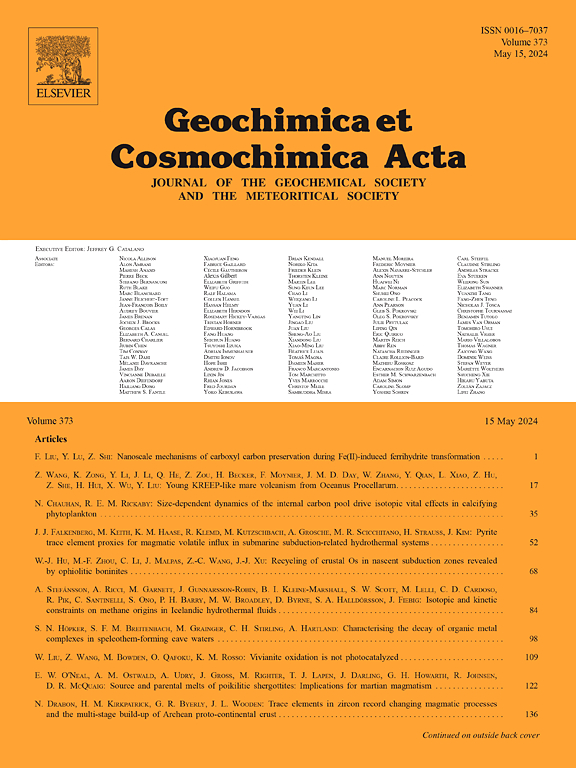Improved solid-state 13C and 15N NMR reveals fundamental compositional divide between refractory dissolved organic carbon and nitrogen in the sea
IF 4.5
1区 地球科学
Q1 GEOCHEMISTRY & GEOPHYSICS
引用次数: 0
Abstract
Marine dissolved organic matter (DOM) is one of the largest reservoirs of organic carbon and nitrogen in the world. Yet, despite its global importance, most DOM remains molecularly uncharacterized. Solid-state nuclear magnetic resonance (NMR) spectroscopy of isolated DOM fractions represents one of the most powerful techniques to understand overall structural composition. However, it is well known that standard cross polarization magic angle spinning (CP/MAS) NMR, the technique used for almost all past solid-state NMR studies of DOM, is at best “semi-quantitative,” and underestimates fully substituted NMR active nuclei. Additionally, almost all past solid-state NMR work analyzed high molecular weight (HMW) material isolated by ultrafiltration, which is now understood to represent mostly 14C-young, “semi-labile” compounds. In contrast, there is far less information regarding the composition of older, low molecular weight (LMW) DOM, which represents the vast majority of the ocean’s accumulated refractory DOM pool.
Here, we applied 13C and 15N solid-state multiCP/MAS NMR, improved NMR methods optimized to more quantitatively resolve fully substituted NMR nuclei, to both HMW and LMW DOM isolated from the surface and deep North Pacific Subtropical Gyre. These methods confirm past work indicating most nitrogen containing HMW DOM as amide compounds, but also demonstrate a modest heterocyclic N component not previously identified. In contrast, we found that LMW DON is almost entirely aromatic heterocyclic N, consistent with the hypothesis that heterocyclic N structures may be largely responsible for the accumulation of the ocean’s refractory DON pool. Surprisingly, however, we find DOC aromatic functionalities still represent only a very minor portion of either the HMW or the LMW refractory carbon pools, in marked contrast to refractory DON composition. Together, these more quantitative solid-state NMR techniques likely represent the most accurate picture of DON and DOC functional and compound-class makeup to date, and so have broad implications for our understanding of marine DOM structure and cycling. Specifically, our new data suggests that while chemical composition likely acts as a key control on DOM lability, the most refractory components of DOC and DON have very different compositions, sources, and cycling, supporting the idea that DOC and DON cycling in the ocean may be largely decoupled.
改进后的固态 13C 和 15N NMR 揭示了海洋中难溶有机碳和氮之间的基本组成分野
海洋溶解有机物(DOM)是世界上最大的有机碳和氮库之一。然而,尽管海洋溶解有机物在全球具有重要意义,但大多数海洋溶解有机物仍未得到分子表征。对分离的 DOM 部分进行固态核磁共振(NMR)光谱分析是了解整体结构组成的最强大技术之一。然而,众所周知,标准交叉偏振魔角旋光(CP/MAS)核磁共振(过去几乎所有 DOM 固体核磁共振研究都采用这种技术)充其量只是 "半定量",而且低估了完全取代的核磁共振活性核。此外,过去几乎所有的固态 NMR 研究都是分析通过超滤分离出来的高分子量(HMW)物质,而现在的理解是,这种物质主要代表 14C 年轻的 "半易变 "化合物。在这里,我们将 13C 和 15N 固态多CP/MAS NMR(经过优化的改进 NMR 方法)应用于从北太平洋亚热带环流表层和深层分离出来的 HMW 和 LMW DOM。这些方法证实了过去的工作,表明大多数含氮的 HMW DOM 都是酰胺化合物,但也证明了以前未发现的少量杂环 N 成分。相比之下,我们发现低分子量 DON 几乎完全是芳香杂环氮,这与杂环氮结构可能在很大程度上导致海洋难溶性 DON 池积累的假设一致。然而,令人惊讶的是,我们发现 DOC 芳香族官能团在高分子量或低分子量难溶碳库中仍然只占很小的一部分,这与难溶 DON 的组成形成了明显的对比。总之,这些更定量的固态核磁共振技术很可能代表了迄今为止最准确的 DON 和 DOC 功能及化合物类别构成图谱,因此对我们了解海洋 DOM 结构和循环具有广泛的意义。具体来说,我们的新数据表明,虽然化学成分可能是 DOM 易变性的关键控制因素,但 DOC 和 DON 中最难分解的成分在组成、来源和循环方面存在很大差异,这支持了一种观点,即海洋中 DOC 和 DON 的循环可能在很大程度上是脱钩的。
本文章由计算机程序翻译,如有差异,请以英文原文为准。
求助全文
约1分钟内获得全文
求助全文
来源期刊

Geochimica et Cosmochimica Acta
地学-地球化学与地球物理
CiteScore
9.60
自引率
14.00%
发文量
437
审稿时长
6 months
期刊介绍:
Geochimica et Cosmochimica Acta publishes research papers in a wide range of subjects in terrestrial geochemistry, meteoritics, and planetary geochemistry. The scope of the journal includes:
1). Physical chemistry of gases, aqueous solutions, glasses, and crystalline solids
2). Igneous and metamorphic petrology
3). Chemical processes in the atmosphere, hydrosphere, biosphere, and lithosphere of the Earth
4). Organic geochemistry
5). Isotope geochemistry
6). Meteoritics and meteorite impacts
7). Lunar science; and
8). Planetary geochemistry.
 求助内容:
求助内容: 应助结果提醒方式:
应助结果提醒方式:


